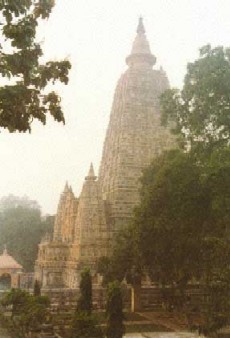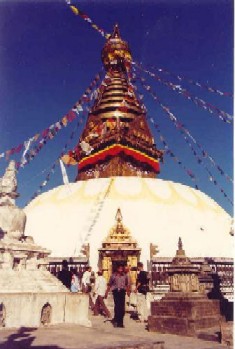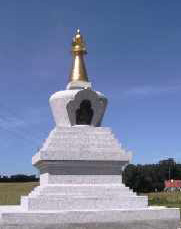 |

All over the world various buildings have arrised during history, which is build
after a special culture or "way of thinking". Many have found it
interesting to study the deeper meaning behind these structures.
Good examples are the pyramides in Africa, the chinese wall, buildings
created by the Greek and Roman.The Celt made stons in rings, while there in
America were people, who created large forms out of stonmaterial. The Mexican
pyramides is another good example.
The Tibetan stupas also has a story..
In the time before Buddha there were a tradition to build marks in the
nature, so travellers could find their way, and they were further used as graves
for special people.
Around year 300 the first stupa was constructed in BodhGaya, India. This was created
by King Ashoka, who was deeply inspired by Buddha's lifestory. The stupa in
BodhGaya is placed very near the exact place where Buddha reached his
enlightment.
Around year 700, the Indian Guru Rinpoche, brought the buddhist teachings to
Tibet, and hereby as well the stupa tradition. Later this tradition spread
itself to Chinas pagoder, the Dagoba in Shri Lanka, the Pagada in Burma. The
tradition is also seen in Afghanistan, Mongolia, Korea, Japan and now in Europe,
USA and Austalia as well.
Meaning
The meaning is to show the potential, which all sentient beings have - the
enligthend essence. Stupas symbolizes the enligthend Buddhas body and teachings.
When you observere a stupa, you collect positive impressions in your mind.
Hereby you get motivated to work with your own potential. Stupas are also a gift
to all sentient beings, as a answer to the deeper meaning of life. Stupas invite
everbody to study, reflect, meditate and thereby develop themselves.
The symbolism refers to the buddhist understanding of the univers - earth,
water, fire, air and nature of mind.
Oberserving a stupa from the ground to the top, one sees the way of
development.: Buddha, the precious buddhist teachings, the realized friends, the
enligthend attitude and joy as foundation to enligthment.
 |
The Swayambhunath stupa in Kathmandu in Nepal is
according to the buddhist history very special. It is said to be self
arisen. In the legends it is said, that in the beginning only
Swayambhunath were above the water in the Kathmandu vally.
On Swayambounath Buddha's eyes are also painted. this shows the
embracing quality the enligthend state brings along.
Near of this very unique stupa, one finds the main Monastey of Lopon Tsechu
Rinpoche, called "Buddha Dharma Center". Rinpoche used the
Swayambhu stupa, as inspiration during long meditation retreats.
|
How to construct a stupa
After the buddhist teachings were brought to our western countries, also stupas
have started to apear. Nowadays many stupas have arrised within the different
lineages of Tibetan Buddhism.
In the west we have the technical methods to construct. But it also demands
that a realized master of buddhism carry out the necessary ceremonies, which are
included in the
building process.
This valuable knowledge have especially Lopon Tsechu Rinpoche given in
the western world.
Rinpoche have during nearly 15 years build around 20 stupas in the west, and
the technical assistance has been given by the Polish architect, Wojtek
Kossowski.
Stupas are build on the same principals, but at the same time each stupa is
individual, and filled according to specific instructions.
Stupas consist of different treasure chambers, which are filled with
various items creating energy. The majority of the chambers are filled with
Tsa-tsa's, small stupa and buddha figures. These you produce yourself, and this
alone, is a major important activity.
The treasure chambers are in the first place filled with stones, weapons as
symbolic protection. Secondly you place articles which you use in agriculture,
and kitchen equipment as you use for producing food and thereby life energy.
Further you place a vase, filled with various jeweller.
However the majority of the chambers are filled with Tsa-tsa's, the buddha
figures. In the chambers you also place special buddhist texts, statues and
mandala's. All chambers are in the end filled with fine sand, so no empty space
is left within.
In the center of a stupa there is placed a tree called a lifetree. On this tree
special mantra's are written, and this is the most essential part of the stupa.
Around the lifetree rolls of mantra's are placed, before it is placed down
inside the stupa.
The elements which are placed inside the stupa, are placed with best
intentions, as these items will later be the foundation, for the great energy
transformed from the stupa. The stupa transforms obstacles to enligthend energy.
On top of the stupa you there is 13 rings, which symbolizes the steps toward
full enlightment. Above these rings there is placed an umbrella, showing that
the stupa is of great value. And finally there is symbols for the moon, sun and
mind.

Lopon Tsechu Rinpoche decides which kind of stupa that shall be constructed at a
specific place. When Rinpoche visited "The Powerful Place" in June
2000, he advised that it should be an enlightment stupa.
The stupa at "The Powerful Place" are situated in
favourable surroundings, among burialplaces which are between 1500-3000
years old.
The enlightment stupa brings creates enligthment to the surroundings, and
transforms obstacles to realized knowledge. At the same time it shows Buddhas
ultimate goal, that each sentient being will reach the enlightend level.
|
 |


